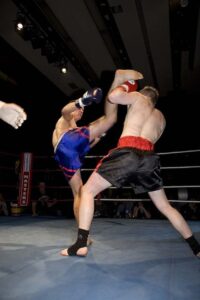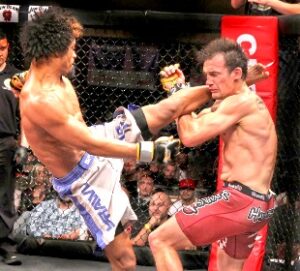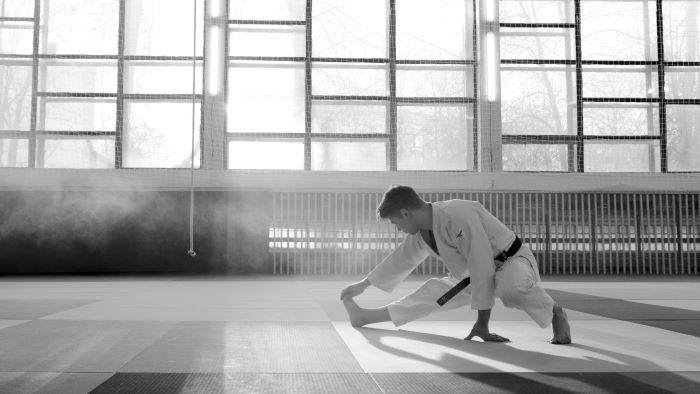
Are you wondering what the best stretches for martial arts or MMA are?
In this article, we’ll examine the 15 best stretches for martial arts/MMA to improve performance and flexibility and reduce injuries.
Contents
- 15 Best Stretches for Martial Arts/MMA
- 1. Forward Lunge Hip Flexor Stretch
- 2. Seated Forward Bend
- 3. Supine Spinal Twist
- 4. Butterfly Stretch (Baddha Konasana)
- 5. Standing Toe Touch
- 6. Warrior 1 (Virabhadrasana I)
- 7. Warrior 2 (Virabhadrasana II)
- 8. Lizard
- 9. Triangle (Trikonasana)
- 10. Pigeon
- 11. Front-to-Back Splits
- 12. Side Splits
- 13. Standing Side Leg Lift and Hold
- 14. Child’s Pose (Balasana)
- 15. Cossack Squat
- Overall
15 Best Stretches for Martial Arts/MMA
Whether it’s MMA, Brazilian jiu-jitsu, Muay Thai, or traditional karate you train, all martial arts demand a combination of strength, speed, endurance, and flexibility.
While most fighters and practitioners focus on the first three, flexibility often gets sidelined. However, it’s an essential component for peak performance and injury prevention, especially for those who fight.
So, in order to achieve Jean-Claude Van Damme flexibility, let’s dive into the 15 best stretches every martial artist should incorporate into a dedicated stretching routine.
1. Forward Lunge Hip Flexor Stretch
The forward lunge hip flexor stretch is essential for martial artists as it targets the hip flexors and quadriceps, muscles crucial for high kicks and grappling maneuvers in disciplines like Muay Thai and Brazilian jiu-jitsu.
By enhancing flexibility in these areas, martial artists can achieve a greater range of motion and power in their techniques.
How to Do It:
- Start on your knees.
- Step forward with one foot into a lunge position, aligning the knee with the ankle.
- Keep your back straight and lean forward through your hips.
- Hold the stretch for 20-30 seconds and switch legs.
2. Seated Forward Bend

This stretch is vital for martial artists as it improves hamstring flexibility, aiding in kick height and reducing lower back strain, especially in taekwondo and kickboxing where high kicks are frequent.
It also stretches the spine and shoulders, so it’s perfect for martial artists, especially MMA fighters who do a lot of cardiovascular exercise like running.
How to Do It:
- Sit on the ground with your legs extended straight.
- Hinge at the hips and reach forward towards your toes.
- Keep your back straight and hold for 20-30 seconds.
3. Supine Spinal Twist
The supine spinal twist primarily targets the spine, obliques, and glutes, promoting overall spinal flexibility. In martial arts disciplines like Brazilian jiu-jitsu, judo, and wrestling, a flexible spine is vital.
It enhances rotational movements and range of motion, crucial for throws and submission defenses, and reduces the risk of injury during ground fighting.
How to Do It:
- Lie flat on your back.
- Extend your arms to the sides at shoulder level.
- Bend one knee and rotate your hips to bring the knee across your body.
- Turn your head to the opposite side.
- Keep the shoulder opposite to your crossing leg on the ground.
- Hold for 20-30 seconds and switch sides.
4. Butterfly Stretch (Baddha Konasana)
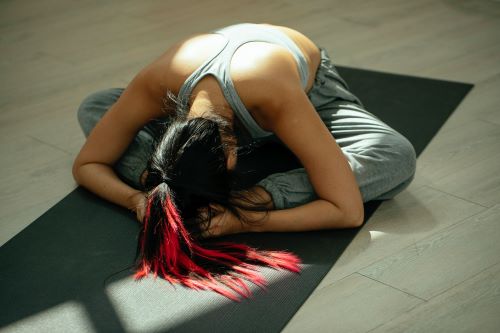
The butterfly stretch is indispensable for martial artists, especially in disciplines like taekwondo and MMA where flexibility in the inner thighs and groin is essential for executing wide stances and high roundhouse kicks.
It also targets the hips and lower back, enhancing the range and fluidity of kicks but also preventing groin strains, a common injury among martial artists.
How to Do It:
- Sit on the ground with your spine straight and legs extended in front of you.
- Bend your knees and bring the soles of your feet together, drawing them close to your pelvis.
- Hold onto your feet or ankles, ensuring your shoulders are relaxed and not hunching up.
- Gently press your knees towards the ground using your elbows. Aim to get your knees as close to the ground as your flexibility allows, but don’t force them.
- While keeping your back straight, you can also hinge slightly at the hips to lean forward for a deeper stretch.
- Hold the stretch for 20-30 seconds, breathing deeply and relaxing into the pose.
5. Standing Toe Touch
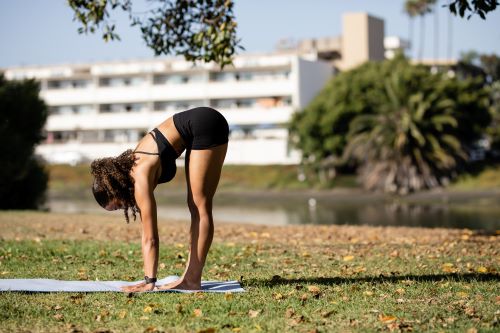
The standing toe touch is crucial for martial artists in disciplines like MMA, kickboxing, and karate, where flexibility in the hamstrings and lower back is key for kicks, stances, and fluid movement.
By targeting these areas, this stretch ensures higher kick reach and reduces the risk of lower back injuries. It’s also very easy to do and can be done anywhere.
How to Do It:
- Stand upright with feet together (or slightly apart).
- Hinge at the hips and reach down towards your toes.
- Keep your knees straight but not locked.
- Allow the back to round a little.
- Hold for 20-30 seconds.
6. Warrior 1 (Virabhadrasana I)

The Warrior 1 pose is a foundational yoga stretch benefiting martial artists by strengthening the legs, core, and back, opening the hips and chest, and improving focus and balance.
It’s particularly beneficial for disciplines that require a strong stance and upper body rotation, such as karate and wrestling.
How to Do It:
- Start in a standing position.
- Step one foot back, turning the foot out at a 45-degree angle.
- Bend the front knee, ensuring it’s aligned with the ankle.
- Raise your arms overhead, palms facing each other.
- Keep your hips squared to the front and gaze forward.
- Hold for 20-30 seconds.
- Switch sides.
7. Warrior 2 (Virabhadrasana II)
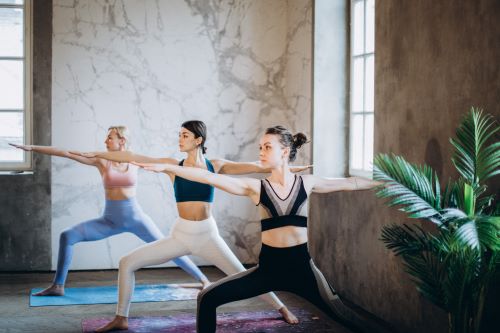
Warrior 2 is essential for martial artists as it strengthens the legs, opens the hips, and stretches the arms and upper body. It’s great for disciplines requiring lateral movement and arm strength, such as boxing, MMA, and karate.
How to Do It:
- Start in a standing position.
- Step one foot back, placing it out at a 90-degree angle, and open the hips.
- Bend the front knee, aligning it with the ankle.
- Extend your arms out to the sides, parallel to the ground.
- Gaze over your front hand.
- Hold for 20-30 seconds.
- Switch sides.
8. Lizard
The lizard stretch is a dynamic hip opener targeting the hip flexors, quadriceps, and hamstrings. Deeply stretching these areas promotes enhanced hip mobility and flexibility, which are essential for a range of martial arts movements.
Hip flexibility aids in achieving more fluid guard transitions, smoother sweeps, and more effective submission setups in Brazilian jiu-jitsu, and delivering powerful high kicks in striking martial arts.
How to Do It:
- Start in a push-up position.
- Step one foot outside the same-side hand, keeping the toes pointed forward.
- Lower down onto your forearms if flexibility allows.
- Keep the back leg straight and press the hips forward.
- Hold for 20-30 seconds.
- Switch sides.
9. Triangle (Trikonasana)

The triangle stretch targets the legs, glutes, groin, neck, and torso, promoting flexibility and a broader range of motion.
Additionally, it opens the shoulders and chest, enhancing upper body flexibility and promoting deeper breathing, vital for stamina and focus in MMA bouts which can be up to 25 minutes long.
The stretch’s rotational aspect also bolsters spinal flexibility and core strength, aiding in the execution of takedowns and throws.
How to Do It:
- Start in a wide-legged stance (about 3 feet).
- Turn one foot forward and the other foot slightly in from a 45-degree angle.
- Face the same direction as your front foot.
- Extend arms out to the sides, forming a T-shape.
- Hinge at the hip and reach the front hand towards the front foot.
- Keep both legs straight.
- Rotate the torso, opening the chest to the side, and reach the other arm upwards.
- Hold for 20-30 seconds.
- Switch sides.
10. Pigeon
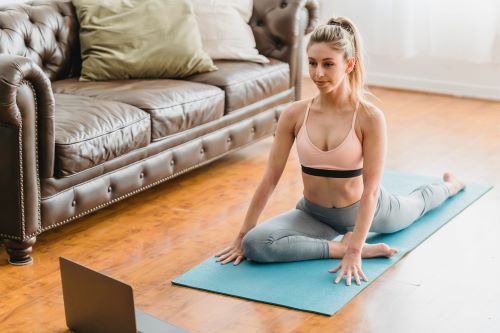
The pigeon stretch stands out as a comprehensive hip opener, effectively targeting the hip flexors, external rotators, glutes, and lower back.
It facilitates smoother guard transitions, allows for tighter leg wraps around opponents, and sets the stage for precise submissions.
Meanwhile, for striking disciplines like Muay Thai and Taekwondo, a flexible hip is a prerequisite for executing a diverse array of powerful and accurate kicks.
How to Do It:
- Start on your knees and hands.
- Bring one knee forward and slide the foot to the opposite side.
- Extend the other leg straight back.
- Square your hips to the ground.
- Lower your torso over the front leg if flexibility allows.
- Hold for 20-30 seconds.
- Switch sides.
11. Front-to-Back Splits
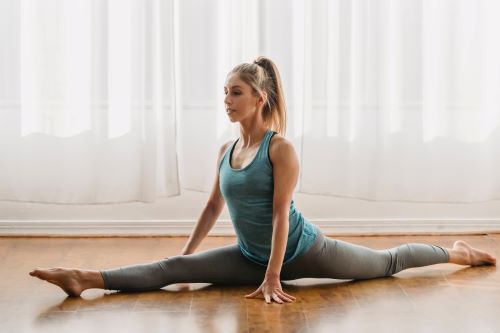
The front-to-back splits, which focus on the hamstrings, hip flexors, and quadriceps, are a hallmark of lower body flexibility.
For martial artists, these splits enhance core strength for potent strikes and better balance. They also safeguard the hip and knee joints from potential injuries and boost agility for swift leg maneuvers and directional shifts.
How to Do It:
- Start in a lunge position.
- Gradually straighten the front leg and slide the back leg backward.
- Keep the hips squared and facing forward.
- Lower down as far as flexibility allows.
- Hold for 20-30 seconds.
- Switch sides.
12. Side Splits
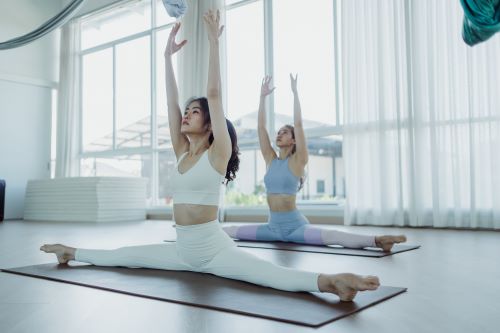
The side splits primarily target the inner thighs, offering a deep stretch that’s indispensable for martial artists.
This enhanced flexibility is crucial for effective lateral movements and executing high side kicks.
Practitioners of disciplines such as Muay Thai and Kickboxing, where swift legwork and powerful kicks are paramount, will find the side splits particularly beneficial in elevating their combat performance.
How to Do It:
- Start in a wide-legged stance.
- Gradually slide the feet out to the sides.
- Lower the hips down as far as flexibility allows.
- Keep the toes pointing forward.
- Hold for 20-30 seconds.
13. Standing Side Leg Lift and Hold
Essentially a static side kick, the standing side leg lift and hold is an essential stretch and strength exercise for martial artists, especially in disciplines like taekwondo, karate, and Muay Thai, where side kicks and lateral movements are frequent.
This exercise not only stretches the inner thighs and groin but also strengthens the outer hip muscles, enhancing the power and height of side kicks.
Additionally, it promotes stability in the supporting leg, which is crucial for maintaining balance during various techniques.
How to Do It:
- Stand upright with feet together and hands on the hips or extended out to the sides for balance (you can also hold onto a chair or other object).
- Engage your core to maintain stability.
- Slowly lift one leg out to the side, keeping the foot flexed and toes pointing forward.
- Lift the leg as high as flexibility and strength allow, ensuring the supporting leg remains straight.
- Hold the leg in the lifted position for 10-15 seconds, feeling the engagement in the outer hip.
- Slowly lower the leg back to the starting position.
- Repeat on the other side.
14. Child’s Pose (Balasana)
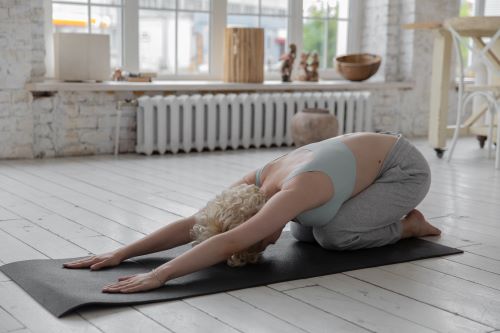
The child’s pose offers a comprehensive stretch to the back, hips, thighs, and ankles.
For martial artists in grappling arts like Brazilian jiu-jitsu or judo, the pose is invaluable as it elongates and realigns the spine and provides relief from potential back and neck strains.
It’s also very calming, allowing martial artists to center themselves and reduce stress, ensuring they’re mentally and physically prepared for the next bout or training challenge.
How to Do It:
- Start by kneeling on the floor with your big toes touching and knees spread apart.
- Sit back onto your heels.
- Extend your arms forward on the ground, palms facing down.
- Lower your forehead to the floor, relaxing your neck.
- Breathe deeply, feeling the stretch in your back and hips.
- Hold the pose for 30 seconds to a few minutes, depending on your comfort level.
15. Cossack Squat

The cossack squat is a dynamic exercise offering martial artists a deep stretch and strengthening of the legs, particularly the inner thighs, hamstrings, and quadriceps.
For martial artists in disciplines like Muay Thai, kickboxing, or MMA, where lateral movements, kicks, and stances are frequent, this exercise enhances flexibility, strength, and mobility in the lower body.
It’s especially beneficial for improving the range of motion in the hips, aiding in higher and more fluid kicks.
How to Do It:
- Start in a wide-legged stance, with feet spread wider than shoulder-width apart.
- Turn your toes slightly outward, around 30 to 40 degrees.
- Shift your weight to one side, bending the knee of that leg while keeping the other leg straight.
- Go as deep as your flexibility allows, ensuring the heel of the bent leg remains on the ground.
- The toes of the straight leg should point upward as much as possible.
- Keep a tall spine, your chest upright, and your core engaged.
- Hold the bottom position for a moment, feeling the stretch in the inner thigh of the straight leg.
- Push through the bent leg to return to the starting position.
- Repeat on the other side.
Overall
This has been the 15 best stretches for MMA/martial arts flexibility and performance.
Using any combination of these 15 stretches in a dedicated stretching routine 5 times per week will help take your martial arts flexibility and performance to the next level, as well as reduce tightness and prevent injury.
If you feel one of the best stretches for martial arts/MMA is missing from this list, comment on the stretch below so it can be added.



